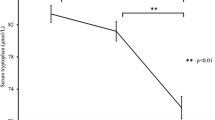Abstract
Tryptophan is the precursor for the important neurotransmitter, 5-hydroxytryptamine (5-HT). Tryptophan is unique among amino acids in that some of it binds to albumin in the blood: thus, blood contains both bound and free tryptophan. Free tryptophan is thought to compete with some other amino acids, particularly the branched chain amino acids (valine, leucine and isoleucine; BCAA) for entry into the brain across the blood-brain barrier (19). There is evidence that changes in the concentration of plasma free tryptophan may influence the level of 5-HT within the brain (see 14). An increase in the plasma concentration ratio of free tryptophan/BCAA could therefore lead to a marked increase in the rate of entry of tryptophan into the brain, and consequently to an increase in the concentration of 5-HT in some areas of the brain. This has been shown to be the case in the rat (6).
Access this chapter
Tax calculation will be finalised at checkout
Purchases are for personal use only
Preview
Unable to display preview. Download preview PDF.
Similar content being viewed by others
References
Ardawi, M.S.M. and E.A. Newsholme. Glutamine metabolism in lymphocytes of the rat. Biochem. J., 212: 835–842 1983.
Bailey, S.P., J.M. Davis and E.N. Ahlborn. Effects of increased brain serotonergic activity on endurance performance in the rat. Acta Physiol Scand., 145: 75 1992.
Bailey, S.P., J.M. Davis and E.N. Ahlborn. Neuroendocrine and substrate responses to altered brain 5-HT activity during prolonged exercise to fatigue. J. Appl. Physiol., 74: 3006–3012 1992.
Blomstrand, E., S. Andersson. P. Hassmen,. B. Ekblom and E.A. Newsholme. Effect of branched-chain amino acid and carbohydrate supplementation on the exercise-induced change in plasma and muscle concentration of amino acids in human subjects. Acta Physiol. Scand., 153: 87–96 1995.
Blomstrand, E., F. Celsing and E.A. Newsholme. Changes in plasma concentrations of aromatic and branched-chain amino acids during sustained exercise in man and their possible role in fatigue. Acta Physiol. Scand., 133: 115 1988.
Blomstrand, E., D. Perrett M. Parry-Billings and E.A. Newsholme. Effect of sustained exercise on plasma amino acid concentrations and on 5-hydroxytryptamine metabolism in six different brain regions in the rat. Acta Physiol. Scand., 136: 473–481 1989.
Blomstrand, E., P. Hassmen B. Ekblom and E.A. Newsholme. Administration of branched-chain amino acids during sustained exercise; effects on preformance and on plasma concentration of some amino acids. Eur. J. Appl. Physiol., 63: 83 1991.
Blomstrand, E., P. Hassmem and E.A. Newsholme. Effects of branched-chain supplementation on mental performance. Acta Physiol. Scand., 143: 225 1991.
Castell, L.M., C.T Lui and E.A. Newsholme. Diurnal variation of plasma glutamine and arginine in normal and fasting subjects. Proc. Nutr. Soc. 54: 118A 1995.
Cowen, P.J., M. Parry-Billings and E.A. Newsholme. Decreased plasma tryptophan levels in major depression. J. Affective Disorders, 16: 27–31 1989.
Chauloff, F., J.L. Elghozi, Y. Guenzennec and D. Laude. Effects of conditioned running on plasma, liver and brain tryptophan and on brain 5-hydroxytryptamine metabolism of the rat. Br. J. Pharmacol., 86: 33 1985.
Davis, J.M., S.P. Bailey, J.A. Woods, F.J. Galiano, M.T. Hamilton and W.P. Bartoli. Effects of carbohydrate feedings on plasma free tryptophan and branched-chain amino acids during prolonged cycling. Eur. J. Appl Physiol., 65: 513–519 1992.
Edwards, R.H.T. In: Biochemical Basis of Fatigue, edited by H.G Knuttgen. pp. 3–28.Champaign, II: Human Kinetics, 1983, pp. 3–28.
Fernstrom, J.D. and R.J. Wurtman. Control of the brain serotinin levels by diet. Adv. Biochem. Psychopharm., 11: 133 1990.
Gibson, H., N. Carroll, J.E. Clague and R.H.T. Edwards. Exercise performance and fatiguability in patients with chronic fatigue syndrome. J. Neurol. Neurosurg.Psych., 56: 993–998 1993.
Hassmen, P., E. Blomstrand, B. Ekblom and E.A. Newsholme. Branched-chain amino acid supplementation during 30-Km competitive run: mood and cognitive performance. Nutrition, 10: 1–5 1994.
Newsholme, E.A. Application of knowledge of metabolic integration to the problem of metabolic limitations in middle distance and marathon running. Acta Physiol. Scand. Suppl. 128:(556) 93 1986.
Newsholme, E.A., B. Crabtree and M.S.M. Ardawi. Glutamine metabolism in lymphocytes: its biochemical, physiological and clinical importance. Q. J. Exp. Physiol., 70: 473–489, 1985.
Pardridge, W. M. Kinetics of competitive inhibition of neutral amino acid transport across the blood-brain barrier. J. Neurochem., 28: 103 1977.
Parry-Billings, M., R. Budgett, Y. Koutedakis, E. Blomstrand, S. Brooks, C. Williams, P. Calder, S. Pilling, R. Baigrie and E.A. Newsholme. Plasma amino acid concentrations in the overtraining syndrome: possible effects on the immune system. Med. Sci. Sports Exerc. 24: 1353–1358 1992.
Petruzzello, S. J., D. M. Landers, J. Pie and J. Billie. Effect of branched-chain amino acid supplements on exercise-related mood and performance (Abstract). Med. Sci. Sports Exerc. 24: (Suppl), S2 1992.
Salmon, P. Nutrition, cognitive performance, and mental fatigue. Nutrition, 10: 427–428 1994.
Sharpe, M. et al. A report — chronic fatigue syndrome: guidelines for research. J. Roy. Soc. Med., 84: 118–121 1991.
Wilson, W. M. and R. J. Maughan. Evidence for a possible role of 5-hydroxytryptamine in the genesis of fatigue in man: administration of paroxetine, a 5-HT re-uptake inhibitor, reduces the capacity to perform prolonged exercise. Exp. Physiol., 77: 921 1992.
Yamamoto, T., L. M. Castell, J. Botella, A. Young, H. Powell, G.M. Hall and E.A. Newsholme. Alterations in the plasma concentrations of tryptophan and albumin may contribute to post-operative fatigue. Brain Res Bull. (In press).
Author information
Authors and Affiliations
Editor information
Editors and Affiliations
Rights and permissions
Copyright information
© 1996 Springer Science+Business Media New York
About this chapter
Cite this chapter
Newsholme, E.A., Castell, L.M. (1996). Can Amino Acids Influence Exercise Performance in Athletes?. In: Steinacker, J.M., Ward, S.A. (eds) The Physiology and Pathophysiology of Exercise Tolerance. Springer, Boston, MA. https://doi.org/10.1007/978-1-4615-5887-3_39
Download citation
DOI: https://doi.org/10.1007/978-1-4615-5887-3_39
Publisher Name: Springer, Boston, MA
Print ISBN: 978-1-4613-7700-9
Online ISBN: 978-1-4615-5887-3
eBook Packages: Springer Book Archive




